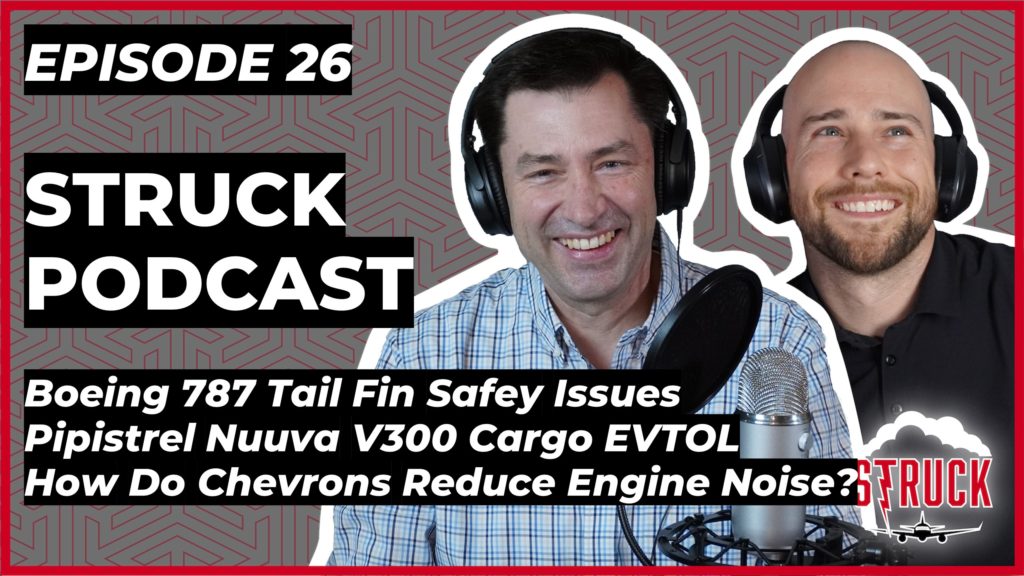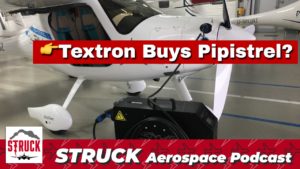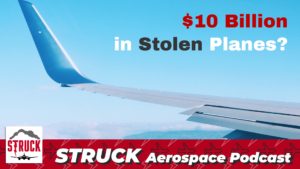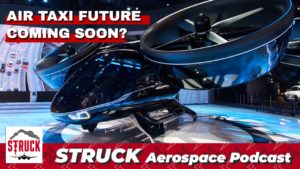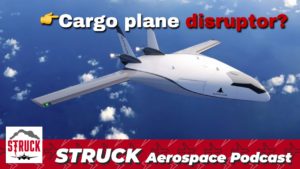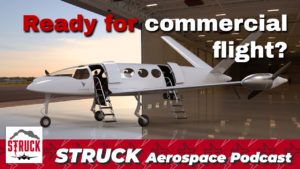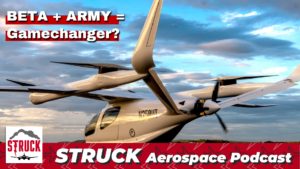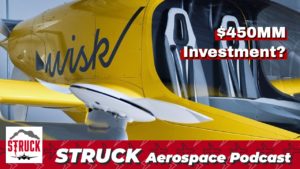In this episode we discuss Boeing 787 tail fin safety issues that appear to be related to shimming. The Boeing 737 Max also went through EASA testing, and a bit of it is beginning to feel politically charged…the Pipistrel Nuuva V300 is a potentially game-changing cargo EVTOL aircraft that could be delivering cargo to remote locations that were previously accessible only by helicopter. Lastly, we dive into the technology behind Chevrons, serrations cut into the trailing edges of jet engine nacelles and nozzles that reduce noise.
Learn more about Weather Guard StrikeTape segmented lightning diverter strips. Follow the show on YouTube, Twitter, Linkedin and visit us on the web. Have a question we can answer on the show? Email us!
Podcast: Play in new window | Download
Full Transcript: EP26 Boeing 787 Tail Fin Problems; Pipistrel Nuuva V300 & Chevrons on Jet Engines; Boeing 737 EASA Testing
Dan: And here on struck, we talk about everything. Aviation, aerospace engineering, and lightening protection.
All right, welcome back. This is the struck podcast episode 26. I am your cohost Dan Blewett and I’m joined here. Remotely with our lighting protection expert. Allen Hall, Allen, how are you?
Allen Hall: Hey, great. Dan, boy–another troubling week for Boeing with the seven 87 on the engineering side of all things, uh, is just the hits.
Keep on coming there. It’s gotta stop at some point. Don’t you think?
Dan: You think so it’s like spreading amongst their fleet now. So in today’s show, we’re going to start with some of the 737 max testing. So Yas has been testing them and we’ll talk about. What they, uh, what they’re doing and how it’s going.
Um, and our engineering segment where we’re talking about Boeing 787 issues. So the Dreamliners got some vertical fin safety issues. Uh, it sounds like shim problems, so yikes and other potential nightmare, I guess, for right now. Um, also we’re going to chat a little bit about chevrons and their use in reducing, uh, engine noise.
Cause obviously jet engines are like the. Most intensely loud things on the planet. So every effort to reduce that as important, even a couple of decibels. And then lastly, in our electric tech session, we’ll talk about, uh, PIPA stroll. And one of their new cargo planes that they’re hoping can really take off.
Uh, no pun intended. The Nuuva V300 is they’re hoping can tackle, uh, the helicopter market and replace them where, you know, we’ve got to ship cargo out to an oil rig, or we got to ship it out. So some other place where helicopters traditionally, the only place that can get there, but these EVTOLs are going to be coming for that market.
So I know you, um, Are a proponent of getting away from helicopters, which are many respects. Do you think more difficult to maintain and have some pretty spectacular failures when they do fail? Which is scary. So, anyway, so let’s talk with, uh, let’s talk first about the 737 max. So Yas has been testing it.
How has it been going?
Allen Hall: 737 flight testing concluded up in Vancouver, British Columbia, uh, just recently with, um, looked like there was multiple certification authorities, uh, participating in that, uh, EASA, obviously transport Canada would have been there and it sounds like the Brazilians were there too.
So there is. A lot of eyeballs on the 737, the, the flight Teske, uh, would be a low risk thing at this point. So there has been at least listened to the news. Reports has been no unexpected outcome of that. Boeing would have had been flying at any way. And check in to make sure that the angle of attack sensors and all the, um, all the sort of the flight management, uh, difficulties that they had would have, would have been taken care of.
So it’s, it’s a check in the box, but also to, to, uh, have some external eyes watching what happens in the cockpit and see how pilots respond to stuff. So, um, that’s a good checkpoint to have done. The next step though, is probably the most important, and I always get frustrated when I see this, when. I think it was in the EASA representative, said, well, we’re going to make sure that it’s safe.
Well, the FAA is the prime certification authority. It’d be like if a Airbus’s certifying a new Airbus, a three, whatever that he also would be the lead on it. And, uh, the FAA would just be sort of in a verification mode, not a recertification mode. So when we see things in the press that sound like EASA is taking a recertification mode that they’re going to.
Take the FAA data as something nice to have, but they’re going to do their own little, um, certification approval in a sense. That’s frustrating. That’s really frustrating because then it’s just left up to opinion. There are rules, the rules between the United States and all the other certification authorities in the world are pretty closely aligned.
I doubt there was any differences between EASA and the FAA in these particular areas. So what’s the holdup once the FAA has signed it off and blessed it, and you also can do the review of it, like they should. Rightly so, but now, now we’re in some sort of negotiation phase. So they’re going to be meeting at Gatwick airport in London, Boeing EASA, transport, Canada sounded like the pretty much anybody you want to show up to the, to the party and, uh, talk about things like pilot training issues.
What is involved with that? Um, Any sort of flight manual adjustments that are proposed would be discussed in there and hammer out those details. And I would assume the FAA is going to be there also. So you like to be a fly on the wall in that place. Cause it’s probably a little bit of loud talking will happen.
Uh, and we’re an election year in the United States, of course, which adds to the level of intensity to what’s happening. I, you know, Dan, I just. Really struggled with some of these things. It isn’t like the FAA made a horrendous mistake. I think there was just a lot of complexity to what had happened originally.
And he also didn’t catch it either, um, in their review and they had a chance to review it too. And I think it just, the complexity caught up everybody because systems were coming more and more complex. And particularly as we add them onto older generation aircraft, after now, we’re in this sort of, I don’t trust you.
Um, Scenario, which is, is doesn’t get bill doesn’t build good bilateral relationships. And the FAA has been trying to do that for the last several years. And it’s just not good for the industry. And hopefully the FAA doesn’t do it to Airbus. Right. That’s the point is that we don’t hold it up because we can, we’re holding up because there’s some real risk and, um, None of the accidents happen in European flight territory.
So we’ll see. Right. Don’t you get don’t you get the feeling like this, unless it’s political at this point.
Dan: Yeah. It feels a little strange, like they’re not necessarily working together and that they’re trying to. Go their own way. It’s yeah. It’s it seems strange.
Allen Hall: Yeah.
Dan: Engineering segment here. We’ve got some more Boeing seven or some more Boeing aircraft stuff. So this is the 787. The Dreamliner. Um, and they’ve got some vertical tailfin issues. So it sounds like at the end of last year, this was starting to be addressed. It was found. And, um, I guess like shimmed gaps, uh, weren’t quite where they needed to be.
And you said shimming is actually a really. Difficult task as far as making certain parts that have to get a very, exactly line up like it’s. And it sounds really, really tough cause obviously like I used to work on cars and high school into college, and sometimes you have to be extremely precise trying to slide the right one in there.
So I can imagine aviation and aerospace. It’s just way, way more at stake. So tell us a little bit about this, this problem.
Allen Hall: So shimming is a commonly used techniques to made up to usually larger parts. And as you get as parts get larger and you try to have very exact interfaces between large part A and large part B.
What you’ll find is that they don’t exactly fit. And when you try to put fasteners bolts and things of that sort. Yeah. Through those structures to tighten them together, basically holding together slight variations, uh, between the two can cause issues on those fasteners. Um, so if the parts aren’t exactly flat flush made it together, then you need to fill those voids.
With something so that you do get flat flush loaded joints, uh, because you can break the, you can break the bolts of the fasteners off where he can break in the case of composite structure, you start breaking up, breaking apart to composite structure. So if you think about in the one that I first remember on the 777, when it sound like they had an app fuselage to fuselage joint, so you get these two round.
Things that are heavy and gravity kind of makes them oblong. So you have to actually make them round again with fixturing and you kind of stick them together and then, uh, add shims were needed. Now there’s really, there’s three ways to shim something. So you can put what we call it, liquid Shem. So it’s like an epoxy essentially that you fill that void up with.
So you actually make the two together, fill that void up, pull them apart. And, um, inspect them and then put it back together with that poxy in place, and then put the bolts in that’s the liquid Shem, there is a solid Shem. So typically a piece of carbon fiber or fiber glass, or in matter of a place should be like peelable shims, aluminum shims, but anyhow, uh, you would put a solid piece between them.
So you’d actually look at the parts. Go in there and measure them. If they’re too wide apart, you’d actually stick in a piece of plastic or metal. And then when the bolt comes through, everything’s flush and then there’s some things that are just like, sort of in between. So it’s sort of like liquid solid combination of the two.
So you do mostly solid and then you put liquid inside of there. Everybody has their own way, way of doing it. But the difficulty is, is that when you, when you first make that. A connection. Oh, you put the two pieces together and you’re checking for gaps. That’s sorta like a little bit of an artwork thing.
Uh, and it takes a lot of knowledge and you have to have experience doing it because it’s not easy because we do in large structure, like a vertical stabilizer and it kind of bumps into the back of the, of the, of the fuselage back there. That’s a big joint and there’s in any sort of misalignment between those two, as you’re trying to shim or result in incorrect shaming.
Or if, uh, and, and this is the can be an issue with some of the liquids, if you don’t mix them properly and they don’t set up right. Well, or they’re too brittle at the end, then they may break or, or not be as reliable and be too soft to handle the load. So, uh, you, you gotta really be careful this year. W what, the 77 thing sounds like, like is that they have a general shimming issue.
Either the process processes off the fixturing is off the training is off something that’s sort of a universal that’s going on. Whereas they assemble the larger components of the aircraft. They’re not getting the pieces properly shimmed, uh, you know, and you sort of your worst case nightmare, Detroit automotive adventures, where people were sabotaging that kind of cars for a while when they were going on strike, you think my gosh, who would sabotage a car?
Well, you know, It’s stuff like that occasionally does happen on airplanes and people go to jail for that stuff. And rightly so, so hopefully this is just a process issue and not some sort of other significant issue, because right now, the thing that’s going on with the 77 sevens, you got two factories only, only really need one.
And right. And when that happens and you got a nonunion shop in South Carolina, which is where these problems appear to be, and then you got the union shop up in Washington state. So it wouldn’t be beyond the realm of thinking that there’s something going on there. Hopefully we’re tracking it down right now.
We’ve got this issue figured out, but there are aircraft out in the field right now where there’s eight. I think there’s a total of eight that they flagged so far. But as they go through this process of trying to figure out where other shimming issues may occur, that may grow a little bit. The problem is if you think about, and Dan, if you think about, I’ll give you the good example on ships, like so on shims, uh, and like in a, in a motor there shims in a automotive motor.
Right, uh, for lifters, whatever. So if when you shims can be buried deep inside of things, and if you have to take apart an automotive engine, it takes a while to fix the shims. You get the wrong shims in there, or you got it, the wrong shims and your suspension. It’s not like a five minute task. Well, some of these, some of these shims on these aircraft are going to take days, weeks to.
To fix, uh, you basically to take apart the joint, measure it, support it while you’re doing that. And then reassemble the thing properly. You’re going to eat up a bunch of time that you wouldn’t don’t have scheduled right now. So the cost is not so much in. The, you know, just the piece parts. It’s not a piece part, hopefully it’s not just not a piece part issue where you’re placing large sections of the aircraft.
It’s more of, I got to take apart. These joints probably take out fasteners, remeasure, reshape them, put it all back together. Reinspect. Oh, yeah. I was just going to have a bunch of time. Those, those things are deep, deep in the aircraft structure. So fun days ahead for some 77, uh, Boeing employees to go fix all those things.
Dan: Yeah. It sounds like a ton of work and it just like another thing added just to the pile of a, of. Boeing issues lately. So it’s unfortunate. Yeah. So let’s talk a little bit about Chevron. So obviously jet engines crazy loud, and it’s an issue because as they redesign airports and they try to expand airports and expand the capacity of airports, um, a friend of mine was actually a consultant and she worked for a company that would do these environmental studies for airports.
And they’d see like, They have to be within certain specs of how much noise is leaking out into the community. And there’s lots and lots of stuff involved. So it’s important business and there’s a lot at stake trying to keep noise down, coming from airport. So Chevron’s are these cutting and I’ve seen them in, on, on the runway.
And a lot of Southwest jets have them. I was like, why is it shaped like that? But what is the shape? I mean, it makes it look kind of like a. Hmm, almost like a flame sort of thing. Like it’s pretty sharp into like, uh what’s. So what’s the deal with these, uh, called chevrons?
Allen Hall: Well, it’s just like a ripple on the trailing edge of the engine, the cells on the back end and they used to call them, um, Daisy pedals.
Um, what we used to be called hush kits this since back in the seventies, early eighties, uh, nor Nam in Oklahoma was one of the first ones to put. We called hush kits, uh, which are additions to the backends of seven 37 agents because the original seven 37 inches. Basically a jet engine. So there were noisy and smoky too.
So they added these, um, uh, tailored, shaped Dade kind of looked like a flower. If you looked at the end of it, shaped exhaust systems to, uh, to quiet. Down the engine noise. And so what you’re doing is you’re basically, uh, mixing the hot air from the center of the engine where the hot section of the engine is to the outer area, which is where the fan case, where the fan blade is.
And you’re trying to use the cold air and the warm air that would come on off and not because the hot air is expanding. So what you’re hearing in the jet engine is the hot air just coming out and expanding rapidly, right? So you want to use that thrust. That’s what propels you to move forward. So, uh, so you got.
Part part fan, obviously you’re blowing the air. That’s part of it. It’s part of the fan, but you also have the mass times acceleration part, which is the burning of fuel. That’s coming out the backend of this jet engine, much like a rocket engine. So that hot air, when it expands, it makes all kinds of noise.
Right? So you hear the hotter expansion. That’s what, why a rocket sounds loud. That’s why a jet engine sounds loud. So what you do is you basically mix cool air and hotter at the back end. You kind of absorb it, take the hot air and kind of. Quasi absorbed into the cold air, so to speak and it lowers the noise down.
So you can do very unique aerodynamic things to control noise, but also increased thrust and increased efficiency. So, uh, if you look in the back end, like if you look at the backend of, uh, uh, any modern. Jet turbo fan engine. You’re going to see all kinds of little, uh, uh, acoustic, uh, devices from the composite structure has specific.
Uh, I was like stainless steel grid and honeycombs and different things inside of the, the structure of those muscles to absorb noise. Are noise, deadening systems. Uh, you, if you look in the back of something, you see you, you see a bunch of like, looks like laser drilled holes on the inside of these cells, which is a sort of a mixing quieting thing also.
So, uh, the serrations. Uh, well, the chevrons you see are similar to what we see on ALS and other brewers, which is a way to keep them quiet. Or now they’re obviously it Al is not burning jet, a creating this rocket noise, but the philosophy is somewhere sort of similar, right? You’re trying to quiet the air flow.
Um, quiet. The expansion of the hot gas is coming out the back end and make it more environmentally. Compatible with the neighborhoods where these airports are located and you’re right. There are specific regulations stand that, that call out how noisy your aircraft engine can be. And they run tests. They have microphones that go out and they measure how noisy the aircraft engine is.
So it’s not just the engine. Obviously the engine is noisy. Let’s just get over that the is noisy. So what you do is it’s all this stuff on the outside, the exhaust nozzle and all the, uh, the cells and the oodles and oodles and piles and piles of money people spend for these new cells, which are not just there as aerodynamic coverings.
They are acoustic devices, really complicated acoustic and thermal devices to quiet. Everything down substantially. That’s why and today, uh, well, I’ll give you an example. So back in the eighties, people complained about living next to airports that don’t move to the airport, but. What has happened over time is that people get closer and closer to the airports.
At the same time, the airplanes had gotten quieter and quieter and quieter. So
Dan: push. Yeah. That’s where they’re getting quieter, right?
Allen Hall: Oh, so the quieter let’s move closer, but also have you, if you flown. Uh, to some of these airports, like Chicago midway, and some others. When you take off, when you take off, like you’d come shooting down the runway, like you’re a formula one race car, and then they pull the nose up and you get this kind of rollercoaster effect going on and they kind of come up and then they kind of use inertia to get them up to the altitude.
And then they cut power. Right. So you’re like, I don’t know, you’re probably 3000 feet or so up in the air and they kinda cut. How are you? Like get this floating effect? Like, you’re like, you’re in a space capsule, the space shot, or a space station or something like, Whoa, I get this negative G effect going on.
And then they thrall it down until they get outside of the city area and then they can throw it all back up again. So not only are they trying to control noise with all the engineering, um, technology that they’re putting into the engine and engine and cells. But they’re also changing the way that the pilots fly the airplane.
It makes it kind of, some of those pilots take that away. It’s a little bit of fun in my opinion, but to make it seem like a little bit of fun, because rarely do you put a commercial aircraft in sort of a negative GG situation, but it sure does feel like you’re on a rollercoaster. Some these flights like, Whoa, I’m starting to float here, but a tight knit seatbelts.
I don’t hit my head on the ceiling. Kind of the feeling. Yeah. So. It’s complicated. Uh, you know, the, the noise rules have been in effect for a number of years now. They’re not new anymore. And when they first came out, it was a big hubbub about it and the world was ending, but. You could like usual engineers step up and do the impossible.
And here we are still flying commercial airlines.
Dan: all right. On our final segment here we talk frequently about, uh, electric, vertical takeoff and landing vehicles. This week is no exception. So today we’re talking about Pippa stroll. They have a cargo plane, the Nuva V3 hundred. And they say can a carry up to 460 kilograms. And really, it seems like they’re going to come after again, the traditional market for helicopters, which yeah, it seems, seems like a natural, a very natural progression.
So you obviously have been in the industry a long time. You have some pretty strong feelings about helicopter. So tell us, Alan, would you like to see helicopters replaced? Cause I think I
Allen Hall: know. Oh yeah, absolutely. Uh, you know, they have a role, obviously you have a role, but having fewer people on them is even better.
Right. Uh, and, and then become a little more utilitarian in the sense that, um, it’s kind of that. W cost reward, risk assessment, risk reward, sort of thing that you want to try to balance out. Is it worth putting people suddenly situations? And if you’ve got a, essentially a disposable aircraft, not any recrafted disposable, but it’s.
Kind is. And if you put it in these rough weather situations, or if you’re going out to fly a flight out to oil rigs, which is in some extreme environments, then if you’re just moving cargo back and forth, then yeah, absolutely. It takes take some of the risk out of, of, uh, losing somebody in the ocean out there because when helicopter crashes into the ocean and you’re on a little life raft out in the middle of nowhere, that’s not fun day.
So it makes sense to use an electric. Unmanned vehicle to move cargo. It sure does. Um, and I, you know, I think they’re just like anything else. Uh, are we, are we trying to create a new marketplace or do we know an existing marketplace we have today, that’s going to make money because the future marketplace is rough.
Cause it may not ever occur. Whereas you like to have some cash flow from. Known sales, right? It’s, it’s sort of the FedEx effect. If you can get FedEx or even Amazon to, to buy your aircraft to do package deliveries. Great. There’s a marketplace there totally is. Do you think that though, that some of these companies like PIP stroll that are involved in this are looking to be purchased though, because if I’m Amazon FedEx ups, um, DHL any, any of these sort of larger players in the package delivery market?
Why wouldn’t I just buy them out and just buy the technology and yeah.
Dan: Yeah, it definitely seems right for that. Right. I mean, and, and to jump back to the autonomous flight. Yeah. I mean, these are going to have a preloaded flight plan. And, you know, they say it’s a highly reliable, um, control. So obviously there’s a lot of, there’s a lot.
That’s going to have to go into proving that like in, you know, in, in real life, but that’s a pretty unique flexibility, but like you said, They don’t know, they’re going to have to find their customers and they’re have to find companies that want to. Yeah, we, we, you know, we’ve been doing the tele copter route and transporting, you know, this, this year.
We’d love to swap it for this, uh, you know, autonomous, um, You know EVTOL but I think like you said, it makes it’s, I think might be a hard proposition to turn down where they’re a small, but growing company, taking on a lot of debt, developing this plane, you know, this aircraft and Amazon’s like, Hey, that’s essentially like a, like a nickel for us to just buy your company.
What do you guys say? You know, all your founders become multi multimillionaires. That’s probably sounds pretty good. You don’t have to find customers and. They just, there it goes so, right. Yeah. I mean, you know, more than, more than, more than I, about how difficult it is to get certified and then B to B. All right.
So let’s start sharing through planes to make money. Like we talked about, you know, with Hector, um, you know, just how hard it is, even with really substantial venture backed capital to get a new aircraft company to market. Obviously pivotal has been around for a while, so they have a track record, but right.
Um, the same time. So it’s a big, it’s a big gun investment there.
Allen Hall: So big financial risk. Yeah, it is. It’s, it’s a hundred million, depending on the size of the single a hundred million to 500 million sort of investment in that you have to get your money back. Airplane by airplane, airplane and selling parts.
So you better have some pretty deep pockets. If you plan on making this thing run, you know, in the long and the long run, you’ll be profitable. If, if you can sell probably a couple hundred of these things, uh, and, and that’s where someone like an Amazon can actually. Provides some help here. One of the, one of the bigger problems on smaller aircraft companies is that the quantities of parts or components that are specific to the aircraft that they’re buying from a suppliers, forces the costs up on the suppliers.
So there’s no quantity as a scale going on here. I’m going to make. 50 of these widgets for these aircraft a year? Well, I can’t tool up for that and that’s, that’s a big problem in that over time. Uh, the, the, the costs go up unless they can get big quantities where if they’ve got a thousand. Aircraft order from Amazon or a 5,000 aircraft order from a FedEx that all changes where you can get that some of that cash up front or FedEx just buys you and takes over.
And they have the impetus and the drive in the logistics chain to kind of find suppliers that can help keep costs down and make the aircraft this less expensive overall. There’s it’s a big driver. This is why new aircraft companies struggled so much because you got to sell a lot of aircraft to get the, you know, your profits to cost ratio gets all screwed up.
If you can’t deliver enough aircraft. So there’s one part about selling aircraft, but you also want to sell enough that your, your costs go down on the component side and, and your overhead gets distributed over a larger number of aircraft and on smaller aircraft quantities that just never really happens.
And it’s a struggle. So. I really seems like a lot of these companies are, are looking for Uber money or Amazon money or somebody Google money that’s to step in and to, to fund them because the engineers are smart and the companies are good. It’s just that the economics aren’t exactly where you’d want them to be right now.
Dan: Yeah. Well, so some, I want to ask you about theirs. This is actually interesting. It says, uh, That the company’s R&D division holds that a EASA design organization approval. Right. So it sounds like that can kind of shortcut the a certification process. Is that it? Can you tell me a little bit about that?
Allen Hall: No.
Dan: Well, maybe it helps them get it there a little quicker.
Allen Hall: Maybe, maybe they’re just, you just have more hands on deck to deal with. Uh, Uh, certification issues. Now you’re, you’re going to get into this sort of raging dispute about, uh, so there’s sort of like two levels here. So you can go through EASA, you can go through the FAA to get an, or transport Canada or any of the certification authorities like in Brazil or in Japan to get your aircraft certified.
So you’re dealing with this sort of outside organization and the case that you asked, you got the right Yassa checks to come. Help you, if you have organizational delegation, you have a like organization or FAA, they call it ODA, organizational delegate, delegation that, that acts as the FAA internal to your company.
So in theory, it should go faster, but you going through the same check boxes all the way through. And so they’re in. This is where Boeing and the seven 37 got all tied up because Boeing was doing some of the certification work internally to them. And the FAA would sort of see the top level. The FAA engineers will see the top level.
They weren’t FAA engine engineers. Weren’t involved in all of it unless he held some specific things that they were going to be checking. And they’re going to take responsibility for. For the most part, these organization, organization, delegations, all the activity happens inside of those things. So can it make it faster?
Yes. Can it. Also cause problems like on the 737. Yes. So it comes, it comes with limited yeah. Patience and the limitation. And as Boeing was drug in front of the front of the U S Congress, and that is not a fun couple of days. That’s what happened. That’s the risk you take is that you’re going to get drug in front of a governmental board.
That’s gonna quote unquote, hold you accountable for some engineer. Uh, interpreting data wrong or making miscalculation or something or, uh, yeah, so, so you gotta be careful, you gotta be really careful with it. And the feeling five years ago was. And the FAA was hostile. All of them are pushing us, ODA, ODA, ODA, OTA.
And I was like, yeah. Okay. We got some independence. We don’t have to call the FAA for everything. Yeah. From a management standpoint. Yay. But from sometimes from the engineer’s perspective, it’s still the same amount of rigor. It doesn’t really make that much difference quite honestly.
Dan: All right. Well, that’ll do it for today’s episode of struck.
If you’re new to the show. Thank you so much for listening. And please leave a review and subscribe on iTunes, Spotify, or wherever you listen to podcasts. Check out the weather guard, lightening tech YouTube channel for video episodes, full interviews and short clips from the show. And follow us on LinkedIn, Twitter, Instagram, and Facebook.
Our handle is @WGlightning tune in next Tuesday for another great episode on aviation, aerospace engineering and lightening protection.
Strike tape, weather guard, lightening techs, proprietary lightning protection for Ray domes provides unmatched durability for years to come. If you need help with your radon lightening protection, reach out to us at weatherguardaero.com. That’s weatherguardaero.com.


